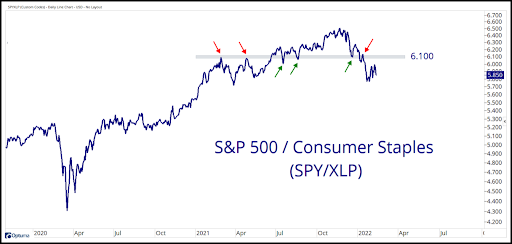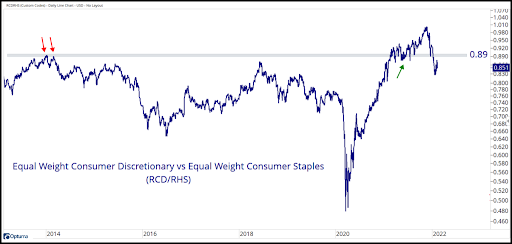Related Blogs
February 22, 2022 | Avalon Team
It’s always something…
Today Putin, last week it was the Fed and inflation, and for so long before that, it was COVID… the headlines du jour.
Most of it is baked into the price of stocks, bonds, or commodities by the time journalists turn your attention to it anyway.
So please tell me, when has it ever paid you to trade based on headlines?
Putin is still hellbent on advancing mother Russia’s position on the world stage beginning with Ukraine, inflation remains at a 40-year high, and the Fed still intends to raise rates in 2022.
It’s mind-boggling… but when you get right down to it, the big question investors should be asking themselves is: Is now the right time to invest, or is it time to be more defensive?
Is the market signaling opportunity or risk? You won’t find the answer in the headlines.
What you want to focus on discovering is if investors, both institutional and retail, are seeking the relative safety of consumer staples, or are they leaning into growth assets.
Two charts we track as a means to visualize these relationships are the relationship between Consumer Staples and the S&P 500 and Consumer Staples vs. Consumer Discretionaries.
Think of them as Opportunity and Growth vs. Defense and Preservation.
Here is a ratio chart comparing the S&P 500 relative to Consumer Staples (SPY/XLP): Growth vs. Defense.

In November of ‘21, this risk-appetite ratio hit its highest level in over 20-years. But in the months since, it has collapsed and flipped from bullish to bearish or risk-on to risk-off.
This didn’t happen last night because of Putin – this has been in play for months, giving investors an opportunity to reallocate part of their investable assets away from growth to more value-centric assets.
What to know: As long as we’re stuck beneath the 2021 first-half highs of 6.10, this signals we’ll remain in a risk-off environment.
It’s too early to tell if SPY/XLP is forming a legitimate trend reversal, but the ratio continues to look more and more like a large topping pattern, which would signify a risk-off environment for investors.
We’re monitoring this one closely for signs of further deterioration.
Another one of our favorite risk appetite ratios is the Equal Weight Consumer Discretionary versus Equal Weight Consumer Staples:
Here, I’m using the equally weighted sector proxies (RCD/RHS). This helps to eliminate the “Amazon effect” as Amazon makes up over 20% of the Consumer Discretionary sector XLY and I want to mute their impact on the direction of the ratio.

Much like SPY/XLP, the Equally weighted RCD/RHS ratio sits just slightly below what I’ll qualify as our long-term risk level of 0.890.
Investors want to see a sustained move above the 0.890 level before we can say risk-on over risk-off.
On a shorter-term basis, RCD/RHS has been a sideways mess for the past year.
What we’re seeing isn’t new. This isn’t something that snuck up on investors in the dark of night.
More often than not, rotation like this isn’t an event, it’s more of a process. A process that has been in the works for months.
So until the broader market (S&P 500) and specifically Consumer Discretionary stocks can regain control, this market will remain mixed at best, with an emphasis on a defensive investment posture.
If you have any questions or have been considering hiring an advisor, then schedule a free consultation with one of our advisors today. There’s no risk or obligation—let's just talk.
Tags

Free Guide: How to Find the Best Advisor for You
Get our absolutely free guide that covers different types of advisory services you'll encounter, differences between RIAs and broker-dealers, questions you’ll want to ask when interviewing advisors, and data any good financial advisor should know about you and your portfolio.

